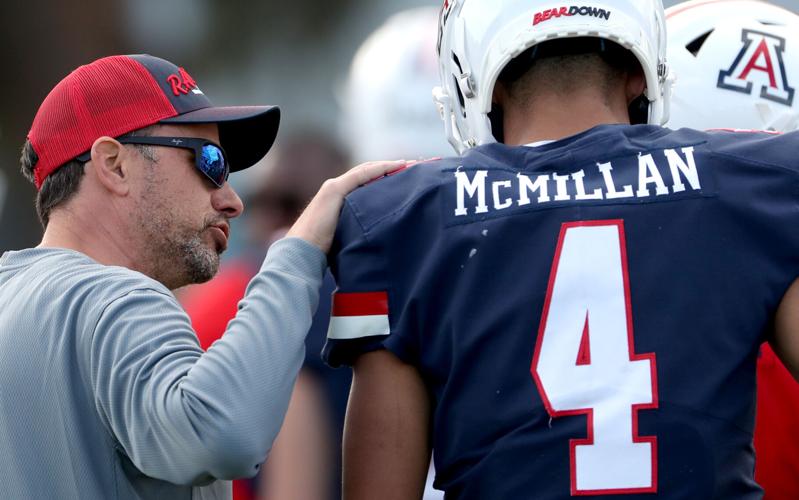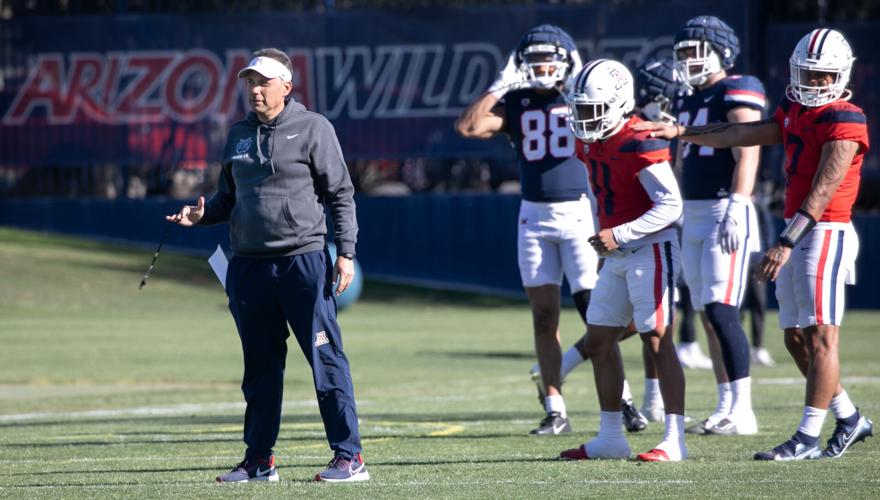Balance is important in life. It’s also important in the red zone.
Through the first week of Arizona’s preseason training camp, red zone battles, whether it’s 7-on-7 or 11-on-11, have been an essential element to the competitiveness the UA coaching stuff under Jedd Fisch instills on the Wildcats.
Some days the offense has the advantage, other days the defense walks away with an intrasquad victory. Sometimes it’s, well, balanced.

Arizona running back Michael Wiley jets into the end zone past ASU defensive back Jordan Clark during the third quarter of Arizona’s 38-35 win over the Sun Devils last November. Wiley rushed for 212 yards and three touchdowns in the victory. Arizona’s 2023 success likely hinges on converting once in the red zone. Translation: Wiley could see the ball in his hands plenty inside the 20 this season.
“(Sunday), the defense got us, then (Monday) the offense balanced it out. Clear winner? No. It’s beautiful. It’s what we want,” Arizona offensive coordinator Brennan Carroll said. “We want the defense to take advantage of us sometimes, and we want to be able to get those guys, so it’s going to make us better as long as we keep competing and stay balanced. It’s right where we want to be right now.”
Last season, the Wildcats converted 81.5% of their trips to the red zone into points, a 6% increase from the 2021, but Arizona ranked 85th nationally in red-zone efficiency despite having the sixth-best passing attack in FBS. The Wildcats’ red-zone defense had an 87.7% efficiency rate — 98th in college football.
Offensively, the Wildcats are striving to convert empty drives and field goals into touchdowns. Defensively, field goals and turnover on downs in the red zone are considered victories and complementary to an Arizona offense that averaged 31 points per contest in 2022 — and returns most of its starters this season.
Fisch said the Arizona coaches “talked as a staff and I talked with the whole team that the two areas where we were porous at in both sides of the ball was red-zone defense and red-zone offense.”

Arizona quarterback Jayden de Laura (7) shovels a pass under pressure from UA linebacker Justin Flowe (10) during the Wildcats’ spring football game at Arizona Stadium on April 15. Limiting turnovers, but just as much converting in the red zone when the Wildcats get inside the opponents’ 20 yard line, are considered keys to the any sort of sustained success coach Jedd Fisch’s team plans to have this season.
“We moved the ball up and down the field statistically on offense, but once we got into the red zone, we were in the 80s, which is just not good enough,” he said. “Defensively, in the 90s, which is just not good enough. We just made a commitment that the first five days of training camp, we weren’t going to go anywhere past the 30-yard line, and we were going to work our way down all practice, every walk-through.
“We haven’t done anything in walk-throughs or in meetings or on the practice field that hasn’t been between the 1- and 29-yard line,” he added. “It’s important, and we have to get better at it.”
So, what led to Arizona’s struggles in the red zone? Well, “a variety of reasons,” according to Carroll.
“The stats tell us that we need to focus on the red zone,” Carroll said. “We want to be in the top 20 in every category, if not higher than that, and we weren’t that last year, so it’s a huge emphasis and it’s a great way to start. We just got to keep double-backing, keep working it. It’s a chance for the defense to steal reps from us, too. It’s valuable across the board. ... That’s why it’s such a huge emphasis.

With his acrobatic ways of getting up to the ball, UA wide receiver Tetairoa McMillan enters 2023 as one of the top red zone options for Arizona coach Jedd Fisch’s offense.
“If it was one thing, we’d fix that and be done with it. We’ve got to run the ball better down there, we’ve got to pass it down there, we got to make great decisions down there and protect the football. All of those things combined will hopefully help us do that. Obviously, we got to have a great attitude when we get down there and expect to score.”
On multiple occasions in the red zone during training camp, Arizona quarterback Jayden de Laura, who has added roughly 20 pounds since transferring to the UA, improvised and ran for gained yards or a touchdown. But de Laura has also been intercepted in the red zone during training camp, which is an encouraging sign for Arizona’s rebuilt defense.
Balance, remember?
“Red zone is what we have to get better at. If we can step our game up in the red zone, it’ll make our offense more dynamic and help our defense,” said Arizona wide receivers coach Kevin Cummings. “It’ll help our defense and it’ll help everything, if we can do that. That’s the main focus. Every year you have a new focus. Receivers specifically, our focus is blocking.
“On offense, our focus is red zone. When you take that emphasis and you focus on that ... you hope to see some improvement, and I think we will.”

Arizona coach Jedd Fisch, left, watches drills standing in front of quarterbacks Noah Fifita (11) and Jayden de Laura (7) during a spring practice in April at the Dick Tomey Practice Fields.
Extra points:
Arizona left tackle Jordan Morgan, who is still recovering from a knee injury he suffered in November, was in full uniform during Monday's practice, but remained sidelined for team periods. Said Carroll: “Right now, he’s in progression back to full speed. He’s done everything we’ve asked, he’s way ahead of the schedule he wanted to get to, but he’s right on schedule for where we want (him). ... He should be full speed in a couple of weeks.”
Redshirt senior tight end Tanner McLachlan caught a touchdown pass from quarterback Jayden de Laura on third-and-goal from the 7-yard line. Roberto Miranda, a redshirt sophomore tight end from Berlin, Germany, and sophomore Keyan Burnett were also among the most active tight ends during team periods.
Junior defensive tackle Tiaoalii Savea, who made critical plays in Arizona’s wins over UCLA and Arizona State last season, was limited in practice on Monday and stayed on the sideline during team period. Fisch said Savea’s undisclosed injury is “nothing major.”
Carroll, on Arizona leaving the Pac-12 for the Big 12 in 2024: “It’s exciting for the university, the program. College football is going to change here in the next couple of years again, so we’ll just ride the wave and see where it takes us.”
Arizona received two votes in the preseason coaches poll that was announced on Monday. The Wildcats either receiver one vote for No. 24 or two votes for No. 25. USC (6), Washington (11), Oregon (15), Oregon State (18) are ranked in the poaches poll.







